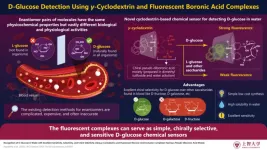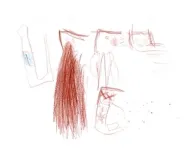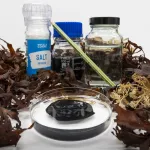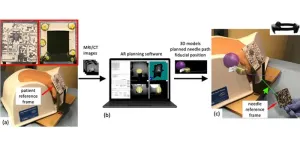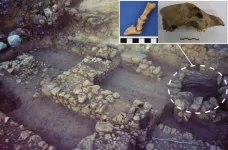Diabetes mellitus, simply called diabetes, is a metabolic disorder characterized by the presence of abnormally high concentrations of glucose in blood. Existing methods for the diagnosis of diabetes rely on traditional techniques of detecting glucose in blood serum samples—a process that is typically tedious and expensive.
Molecular recognition is the science of accurately detecting specific compounds by exploiting their binding properties. Here, a receptor molecule–a kind of sensor–selectively binds to a target molecule. This process triggers some reaction, say, a change in fluorescence. As a result, the target gets detected. Chemical sensors, specialized polymers, and some catalysis techniques work on this principle.
Despite advancements in molecular recognition across decades, developing receptors for detecting chiral (or asymmetric) molecules remains a challenge. Chirality results in enantiomeric pairs, which are non-superimposable “mirror images” of the same molecule. They have identical physical and chemical properties but different biological functions. Their similar structures make them hard to distinguish from each other. Therefore, researchers must employ complex and expensive techniques, such as high-performance liquid chromatography, to tell them apart.
In this light, a group of researchers, including Professor Takashi Hayashita and Dr. Yota Suzuki of the Department of Materials and Life Sciences at Sophia University, has designed an all-new fluorescence recognition method for detecting D-glucose, a chiral monosaccharide, in water. Their work was made available online on 20 December 2022 and published in Volume 8, Issue 1 of ACS Sensors on 27 January 2023.
Dr. Hayashita describes the motivation behind the research. “Most approaches for designing D-glucose chemical sensors require complicated syntheses, often have poor solubility in water, and sometimes have poor selectivity. Therefore, a novel detection mechanism has been developed.”
The researchers developed a complex consisting of γ-cyclodextrin (γ-CyD), which has a cavity that provides a hydrophobic microenvironment to encapsulate hydrophobic compounds spontaneously in an aqueous environment. They then readily synthesized two types of simple hydrophobic fluorescent monoboronic acid-based receptors: a 3-fluorophenylboronic acid-based receptor (1F) and a pyridyl boronic acid-based receptor (2N). They attached two molecules of either receptor to γ-CyD. The resulting inclusion complexes (1F/γ-CyD or 2N/γ-CyD) formed a pseudo-diboronic acid moiety that selectively recognized D-glucose in water at its two sites. This strongly enhanced the fluorescence of the solution. In contrast, only weak fluorescence was observed for nine other saccharides that were tested including D-fructose, D-galactose, and D-mannose, which were typical saccharides contained in the blood. 1F/γ-CyD and 2N/γ-CyD increased the fluorescence by 2.0 and 6.3 times, respectively, for D-glucose, relative to its enantiomer L-glucose. “To the best of our knowledge, 2N/γ-CyD has the highest D/L selectivity among other reported fluorescent diboronic acid molecule-based receptors,” says Dr. Suzuki.
The researchers investigated this phenomenon further through induced circular dichroism spectral and nuclear magnetic resonance studies. They found that a D-glucose molecule bridges the two monoboronic acid molecules. It rigidifies the complex structure and enhances the fluorescence. In the case of non-glucose saccharides, two different molecules bind to the two sites of the pseudo-diboronic acid moiety. As a result, the fluorescence remains weak.
Besides high selectivity, the developed complexes also show remarkable sensitivity. 1F/γ-CyD and 2N/γ-CyD could detect D-glucose concentrations with low limits of detection (LODs) of 1.1 μM and 1.8 μM, respectively. Hence, both complexes can serve as simple D-glucose chemical sensors. They have excellent selectivity, sensitivity, and chiral selectivity.
“The developed fluorescent sensors are useful for detecting D-glucose selectively and discriminating glucose enantiomers. They can potentially also serve as next-generation diagnosing systems for diabetes that can be used with minute amounts of blood sample, which is an indispensable feature when drawing blood from infants. Since their chemical structures are quite simple, these sensors will help develop affordable and reproducible kits for its early diagnosis,” concludes Dr. Hayashita.
Reference
【Title of original paper】Recognition of D‑Glucose in Water with Excellent Sensitivity, Selectivity, and Chiral Selectivity Using γ‑Cyclodextrin and Fluorescent Boronic Acid Inclusion Complexes Having a Pseudo-diboronic Acid Moiety
【Journal】ACS Sensors
【DOI】10.1021/acssensors.2c02087
【Authors】Yota Suzuki1, Yuji Mizuta1, Ayame Mikagi1, Tomoyo Misawa-Suzuki1, Yuji Tsuchido1,2, Tomoaki Sugaya3, Takeshi Hashimoto1, Kazuhiro Ema1, and Takashi Hayashita1
【Affiliations】1Department of Materials and Life Sciences, Faculty of Science and Technology, Sophia University, 2Department of Life Science and Medical Bioscience, Graduate School of Advanced Science and Engineering, Waseda University (TWIns), 3Education Center, Faculty of Engineering, Chiba Institute of Technology
About Sophia University
Established as a private Jesuit affiliated university in 1913, Sophia University is one of the most prestigious universities located in the heart of Tokyo, Japan. Imparting education through 29 departments in 9 faculties and 25 majors in 10 graduate schools, Sophia hosts more than 13,000 students from around the world.
Conceived with the spirit of “For Others, With Others,” Sophia University truly values internationality and neighborliness, and believes in education and research that go beyond national, linguistic, and academic boundaries. Sophia emphasizes on the need for multidisciplinary and fusion research to find solutions for the most pressing global issues like climate change, poverty, conflict, and violence. Over the course of the last century, Sophia has made dedicated efforts to hone future-ready graduates who can contribute their talents and learnings for the benefit of others, and pave the way for a sustainable future while “Bringing the World Together.”
Website: https://www.sophia.ac.jp/eng/
About Professor Takashi Hayashita from Sophia University
Takashi Hayashita is a Professor at the Department of Materials and Life Sciences at the Faculty of Science and Technology at Sophia University. He completed his Ph.D. from Kyushu University in 1985. Since then, he has published around 200 research papers that have been cited thousands of times. Dr. Hayashita serves now the President of the Japan Society for Analytical Chemistry and the Association for Research of Host-Guest and Supramolecular Chemistry. He was recently awarded the 2022 Contribution Award of Japan Society of Ion Exchange by the Japan Society of Ion Exchange. His research group is currently working on design of supramolecular chemosensors for ion and molecule recognition in water. These include chromo-and-fluoro-ionophore complexes with cyclodextrin, dendrimers, and novel amphiphilic chemosensors.
About Dr. Yota Suzuki from Sophia University
Yota Suzuki is a member of Takashi Hayashita lab at the Department of Materials and Life Sciences at the Faculty of Science and Technology at Sophia University. He has published 13 research articles that have been cited more than 50 times. His research interests include molecular recognition, sensors, ionophores, fluorescence, and reaction kinetics. He has recently developed a novel D-glucose detection method that utilizes cyclodextrin and boronic acid receptors.
Funding information
This study was financially supported by a JSPS Research Fellowship for Young Scientists (21J00709), a JSPS Grant-in-Aid for Scientific Research (20H02772), and Sophia University Special Grant for Academic Research “Research in Priority Areas”.
END
